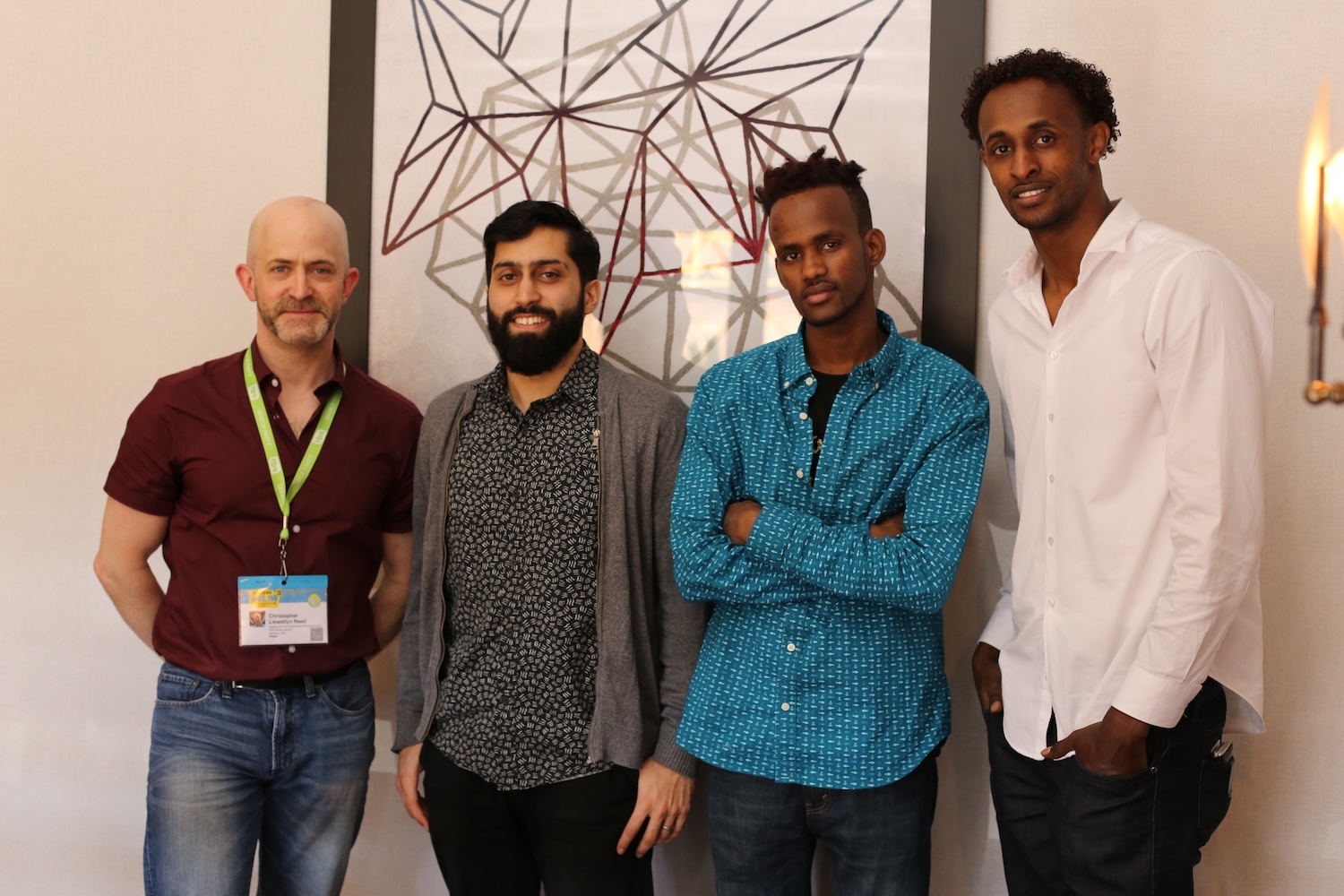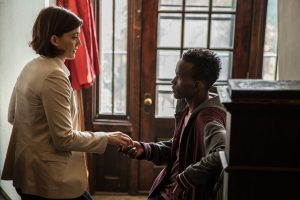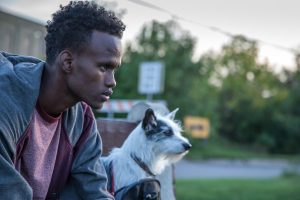A Conversation with Musa Syeed, Barkhad Abdirahman and Faysal Ahmed (A STRAY)

I met with director Musa Syeed, lead actor Barkhad Abdirahman and supporting actor Faysal Ahmed on Monday, March 14, 2016, to discuss their feature film A Stray, for which I also wrote a review, about a young Somali man in Minneapolis who reluctantly adopts a stray dog. Here is a condensed digest of that conversation.
– Christopher Llewellyn Reed
 Hammer to Nail: So I was very interested in the way you display the title of your film, graphically, in the opening credits, in a way that almost elides the “A” and the “Stray,” almost as if you are leaving it up to our imagination whether it’s “Astray,” as in, “I went astray,” or “A Stray.” And of course the question throughout the film is: who is the stray? Right? It could be the character played by Barkhad, the dog, both. So graphically, what was your choice about?
Hammer to Nail: So I was very interested in the way you display the title of your film, graphically, in the opening credits, in a way that almost elides the “A” and the “Stray,” almost as if you are leaving it up to our imagination whether it’s “Astray,” as in, “I went astray,” or “A Stray.” And of course the question throughout the film is: who is the stray? Right? It could be the character played by Barkhad, the dog, both. So graphically, what was your choice about?
MS: Yeah. I like the title. It’s a hard one to say, sometimes. Or for people to grasp. But yeah, we wanted to sort of leave it open. You know, the Italian film The Bicycle Thief, I think the original title in Italian was Bicycle Thieves…
HtN: And it’s become that again. The Criterion Collection release has the plural, once more.
MS: But I actually like the singular, because it leaves the question open, who is the bicycle thief? With the plural, it sort of gives it away that there is going to be more than one, so I kind of like the singular. And so this is similar, in having the singular thing of, who is this stray? I thought about, should I make it a plural, should I make it a verb. But I just kind of liked the singular, because it does sort of play into both uses of the word.
HtN: And the mystery is good.
MS: Yeah.
HtN: I’m glad you mentioned Bicycle Thieves, because I see a direct correlation between your film and Umberto D, another film by Vittorio De Sica, which is the film of his I find the most moving, because I am, in fact, a dog person. It’s beautiful, and it’s got a guy with a dog.
MS: I definitely watched that in preparation for this and watched a lot of dog films to just see how people work with dogs and what would help create a connection with the dog and, for me, what it ultimately came down to in the casting of the dog…what was important was to get a dog that had eyes that you could really look into, and that you could make a connection with. So a dog with defined pupils was the one thing that I was really trying to find.
Ayla, the dog that we found, she’s never been in a film before; she’s just a well-trained dog. Her owners, Karen and Mike, do a lot of agility training, and put her in some competitions, I guess, but she just had the right look and her eyes were…you could kind of look into them and see her as her own character, as opposed to just a prop. And in Umberto D, there are times when the dog just kind of does cutesy things like holding the guy’s hat in his mouth and stuff like that, and that’s another hard thing to work against: the cutesiness factor of a dog in a film and the sentimentality of having a dog in a film, so those were all the kinds of things we tried to keep in mind to strike the right balance.
HtN: Well, she’s adorable. And she also brought to mind, in terms of a dog that just behaves, rather than does tricks, the Jack Russell in the movie Beginners, from a few years ago, starring Christopher Plummer – the one for which he won his Oscar, finally. It’s a dog that doesn’t do a whole lot, other than just be …a dog. It came out the same year as The Artist, in which the late, great Uggie – who was adorable, too – does lots of cute dog tricks. Ayla is like the dog in Beginners. More natural. You wouldn’t want her to do tricks, not in that context. And she does have great eyes.
So I read about your own history rescuing an abandoned dog, Lily, that you then later had to give up for adoption, and you discussed the relationship of dogs within the Muslim community. Have you encountered a fair amount of Muslims, like yourself, from immigrant families, who have decided to keep dogs as pets, and are their experiences similar to the one in your film?
MS: Yeah…I don’t see it being that widespread. And the argument of the film is not that Muslims need to have dogs in their home
HtN: Sure.
MS: but I do see their being a greater comfort level with it in this next generation, but there’s…I see it every once in a while. I was dog-sitting recently, for one of our friends, and my brother was staying with us, also, at that time, and he was, like, I feel so conflicted right now, with this dog around me! He wanted to pet it, but he didn’t want to get too close to it. It was just…it was funny. But I think, for me, my personal story was that I ended up giving this dog away, and part of the film was like rewinding to that moment, because it was this unexpected emotionally fraught moment, which I wish I could sometimes reverse and put myself back there, wondering what I would do differently now.

HtN: I have to say, though, that discomfort with dogs is not unique to Muslims. There are plenty of people who just haven’t grown up with dogs, and have a hard time dealing with them. This is universal.
MS: And I think that a lot of people’s discomfort with them is not just a religious thing, it’s a very multi-layered thing, actually, which seems silly, in some ways, but it brings up a lot of these issues. There’s this post-colonial mentality, there’s identity politics, there’s all these other things that are kind of wrapped up in this very archetypal American relationship of man and dog. That’s why I was really interested to tell the story, because it sort of unpacks that and sees it from a different perspective.
HtN: There’s a very interesting recent book, Citizen Canine, that I recommend, that examines our evolving relationship to dogs, starting as servants, then pets, and now some people are arguing that they should be citizens.
MS: Oh, wow!
HtN: So, Barkhad, I’m curious about your own relationships with dogs. You had to work with Ayla quite a lot. Had you spent a lot of time with dogs before this? Was this a first for you?
BA: It was the first actual dog I met. But before that, I watched videos, and I asked people who have dogs how their relationships with their dogs worked. But this was my first actual relationship with a dog…for fifteen days. The first couple of days were intense, but we got through it, and we learned about each other.
HtN: You seemed to have a nice on-screen rapport. Very comfortable. She seemed to trust you.
BA: Yeah, yeah. It takes five to six days
MS: And a handful of treats
BA: and a handful of treats (laughs) but she was a trained dog, which made it easier for both her and me.
HtN: So I wanted to ask about the representation of the Somali community in Minneapolis. Musa, you cast actors who are Minneapolis residents, and that helps you there. You feel the place, and you feel like it’s almost documentary in some of its representations. How do you, Barkhad and Faysal, feel like it was represented?
BA: For me, the community was represented very well. The beginning of the movie is all about culture, religion and identity, and you actually get to feel that you are there, with this person, and you are going through his daily life with him. It’s a good representation of the community. It’s well done.
FA: For us, it’s a good thing to be represented by people who actually know the surroundings, and shooting something in Minneapolis, itself. Most of the cast members live there. What we, as a group, thought, was that if anyone is going to tell our story, it has to be us. You know? And that’s the best way for us to give everyone else an inside look at our lives and our culture. And I love that about this movie.
HtN: The plot point involving the FBI agent is interesting, and I’m curious, how much of that comes from your imagination, and how much from your research? Did you discover people being informers?

l-r: Christina Baldwin and Barkhad Abdirahman
MS: I didn’t initially include it as part of the story when I first went into it, but I think there are a lot of those tensions right now, and I was talking to one of the civil rights groups that is advocating for the community, and there are different cases of youths who have been pressured, in different ways, to be informants. And one of them, in particular, was offered an iPhone to be an informant, and so that was what we weaved into the story.
I think that sometimes the sense of suspicion…people thought that I was an FBI agent when I got there, because I’m this Muslim guy who’s talking to people, not from there, who’s coming at a weird time. And so it took a little while for people to realize what I was really about (laughs) and it is an issue across the country, I think, not just in this community, but in Muslim communities across the country. Trevor Aaronson – I don’t know if you know him – but he’s written a lot about this sort of “terrorism factory,” where informants are sort of creating some of these issues and manipulating vulnerable people and populations. So for me it was just another source of marginalization, or alienation, that youth are facing. Youth, in general, is a difficult time for anyone, and to have this additional burden, and not feeling as if you can express yourself freely, or think freely, even, is a difficult place to be.
I didn’t want it to be an FBI thriller, however. I wanted to show how, if people do interact with these people, how it actually happens on a day-to-day basis. One of the people that I got to know there is a youth counselor, whom other people call an “Uncle Tom,” who’s very pro-establishment. He told me that someone had seen his picture…that the FBI had shown someone else his picture and was asking about him. So these kinds of things start to make people…it adds another layer of tension to your life.
HtN: Sure. And I can see why you would maybe have been seen as, initially, with some suspicion.
MS: Yeah. (laughs)…(pause)…why do I seem suspicious to you?
HtN: (laughs) No! Because you’re an outsider, coming into the community.
MS: And to be fair, there’s been so much misunderstanding and willful misrepresentation by the media, so it’s understandable why people have those reservations.
HtN: Plus, anytime you come into any group with a camera and start asking questions, people ask, why are you here? I’m curious, Barkhad and Faysal, have you guys encountered situations like the one with the FBI agent, in your own lives in Minneapolis?
BA: No, but we heard about kids who have been through it. Actually, it does happen. More often in the last three or four years. You hear rumors, this or that, FBI here, FBI there, kids getting locked up over informants who give information about them, stuff like that. It’s actually sad, because what’s happening is that it’s the youth getting most of the problems. It’s a sad situation to be in when you live in that community. You don’t know who’s who.
FA: There’s a lack of opportunity, in a lot of ways. One of the things that I personally encountered was, I was doing a casting for HBO series, called The Recruiters, and we started casting for it, we cast one of the kids there, and I think his number was 81 or 82. He was probably one of the last people that we saw. He was really good. So the following day we had a callback, and he was one of the people that we wanted to call back. And I had one of the other representatives with me texting him to come him. And he kept telling us no. And then a week later, I saw him in the news listed as a most-wanted suspect, and he was doing this, he was doing that, and it was just a shock for all of us, because he had so much potential, but…
HtN: So how does one square the assimilation circle? How does one assimilate without losing one’s original cultural identity?

l-r: Barkhad Abdirahman and Ayla
MS: Well, I think that there are other models than assimilation to have social cohesion. I think that’s a big part of the film, for me, that the character ultimately breaks the categorizations into which people might put him. There’s this sort of good Muslim/bad Muslim dichotomy in representations in which we say that the good one is someone who is unquestioning, uncritical, looks just like you and me, that kind of thing; and then the bad Muslim is someone who is critical, speaks his mind, whatever. So the film, ultimately, has this character who can be very compassionate but can also be critical and can be vocal about his opinions, you know, and that’s not a bad thing. People need to be able to be who they are. Our identities can be as big and as all encompassing as we want them to be. For the character to be black, to be Muslim, to be American, to be Somali, to be all these things; he can choose to be all those things. The onus of assimilation is not so much on me, or us, or this community, but it’s on everyone to be able to see the humanity in other people and to be comfortable with difference.
HtN: Well said. Gentlemen, thank you for your time, and I hope a lot of people see your film.
– Christopher Llewellyn Reed (@ChrisReedFilm)









